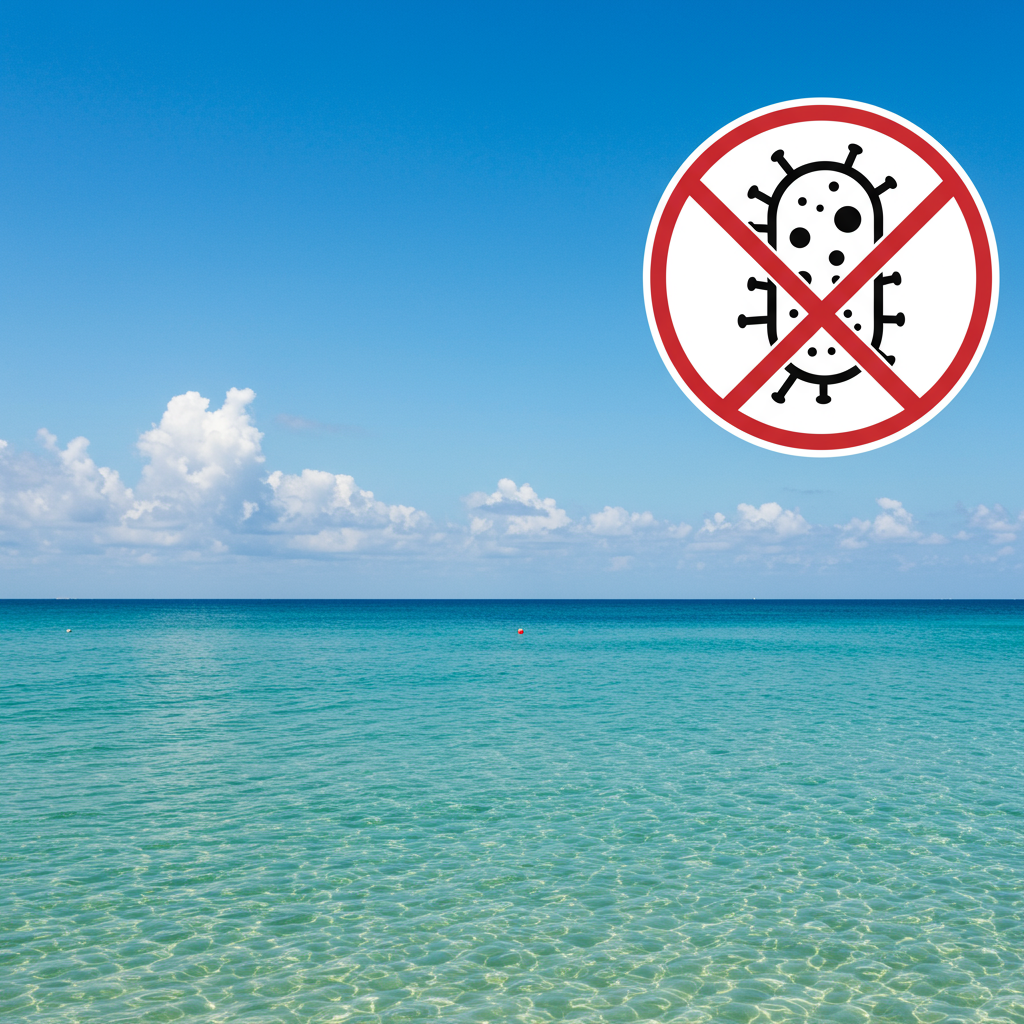Florida residents and visitors face a critical public health concern as Vibrio vulnificus, often mislabeled as “flesh-eating bacteria,” continues to impact communities. As of 2025, the state has reported 16 cases of this dangerous bacterium, leading to five fatalities statewide, including two in Bay County. Understanding the true nature of Vibrio vulnificus, its risks, and essential prevention strategies is paramount for staying safe in Florida’s warm coastal waters.
Understanding Vibrio Vulnificus: More Than a Misnomer
Despite its chilling nickname, Vibrio vulnificus does not literally “eat” flesh. The Centers for Disease Control and Prevention (CDC) clarifies that this bacterium can cause necrotizing fasciitis, a severe infection where the tissue surrounding a wound rapidly dies. This tissue destruction creates the alarming appearance of “flesh being consumed.” It’s a critical distinction, emphasizing the swift and destructive nature of the infection rather than the bacteria consuming tissue.
This particular bacterium thrives in warm, brackish seawater. Cases typically emerge seasonally, primarily between May and October. The Florida Department of Health (FDOH) notes its optimal growth occurs in water temperatures ranging from 68 to 95 degrees Fahrenheit (20-35°C), though it can survive and proliferate in temperatures as high as 105 degrees Fahrenheit (40.5°C). Recent monitoring in St. Andrews Bay and Panama City Beach, for instance, showed water temperatures near 87 and 85 degrees respectively, well within this dangerous range.
The Alarming Impact of Vibrio Vulnificus
While many Vibrio strains lead to mild gastrointestinal issues, Vibrio vulnificus is notably more aggressive and carries a high mortality rate. The CDC estimates roughly 80,000 cases of vibriosis occur annually in the United States. A significant portion, about 52,000, are linked to eating contaminated seafood. However, Vibrio vulnificus stands out due to its severe outcomes.
This bacterium can be fatal in one in five infected individuals, sometimes within a mere 24 to 48 hours. Survivors often require extensive medical care, including intensive care or even limb amputations, due to the rapid destruction of muscle tissue and skin. The latest victim in Florida was 78-year-old Alan Kidd, who tragically died on August 4 after contracting the bacteria on St. George Island in Franklin County. His daughter highlighted the unexpected and devastating nature of such a loss.
Current Landscape: Cases Across Florida and Beyond
The 2025 data reveals a concerning pattern for Florida. With 16 confirmed cases statewide and five fatalities, the bacterium poses a real threat. In Northwest Florida specifically, there has been one case in Okaloosa County, one in Walton County, and two in Escambia County, in addition to the two deaths and two infections in Bay County.
The challenge of Vibrio vulnificus extends beyond Florida’s borders. Nationwide, approximately 60 cases have been confirmed across 11 states. Louisiana has reported 17 cases, resulting in four deaths, while North Carolina has seen seven cases. These figures underscore a broader, escalating public health concern across U.S. coastal regions, particularly in Gulf Coast states like Florida, Louisiana, Texas, Alabama, and Mississippi.
How Infections Occur
Understanding how Vibrio vulnificus spreads is crucial for effective prevention. There are two primary pathways for infection:
Wound Exposure: The most common and often severe route is through an open wound, cut, scrape, or even a recent surgical site, piercing, or tattoo. If exposed to contaminated warm salt or brackish water, the bacteria can enter the bloodstream directly. This can happen during activities like swimming, fishing, or simply wading in affected waters.
Ingestion: Consuming raw or undercooked seafood, particularly oysters, is another significant source of infection. Oysters, as filter feeders, can concentrate the bacteria from their environment. Ingesting contaminated water while swimming can also lead to infection, though this usually results in milder gastrointestinal symptoms. Direct exposure of a wound to raw seafood, for instance while shucking oysters, also presents a risk.
Who Is Most At Risk and Recognizing Symptoms
While anyone can contract a Vibrio vulnificus infection, certain individuals face a significantly higher risk of severe illness and fatality. Those with underlying health conditions such as liver disease, diabetes, and immunocompromising conditions are particularly vulnerable. Individuals who have recently undergone surgery or have compromised immune systems should exercise extreme caution when near coastal waters.
Symptoms of a Vibrio infection can vary depending on the route of exposure:
Gastrointestinal Symptoms (from ingestion): Watery diarrhea, stomach cramps, nausea, vomiting, fever, and chills. These are typically milder.
Bloodstream Infection (from wound or severe ingestion): Rapidly developing fever, chills, dangerously low blood pressure (septic shock), and blistering skin lesions.
Wound Infection (from water/seafood exposure): Fever, redness, intense pain, swelling, warmth, discoloration, and discharge from the wound. These symptoms can progress rapidly.
Health officials strongly advise immediate emergency room visits for anyone suspected of having a Vibrio vulnificus infection, especially if symptoms like fever, rapid pain, or skin changes appear after exposure to warm coastal waters or raw seafood.
Essential Strategies for Prevention
Given the severity of Vibrio vulnificus, proactive prevention is the best defense. Implementing these measures can significantly reduce your risk:
Cook Seafood Thoroughly: Always cook oysters and other shellfish thoroughly before consumption. Avoid eating raw or undercooked seafood.
Protect Open Wounds: If you have any open cuts, scrapes, blisters, or recent surgical sites, avoid contact with warm salt or brackish water. This includes swimming, wading, or even handling raw seafood.
Use Waterproof Bandages: If contact with coastal water or raw seafood is unavoidable, always cover any wounds with a waterproof bandage.
Wear Protective Gear: When handling raw shellfish, especially during activities like shucking oysters, wear protective gloves or clothing to prevent direct contact with potential bacteria.
Prevent Cross-Contamination: Ensure raw seafood does not come into contact with cooked foods or other ingredients to prevent the spread of bacteria.
Stay Vigilant After Storms: Coastal floods, hurricanes, and storm surges can push contaminated coastal waters inland. Exercise increased caution after such events, as they can heighten the risk of wound infections.
Environmental Factors and Climate Change
The prevalence of Vibrio vulnificus is not solely dependent on human interaction; environmental factors play a critical role. Research has linked higher concentrations of the bacteria to:
Sanitary Sewer Overflows: Malfunctioning or overwhelmed sewer systems can release untreated waste into waterways.
Leaky Septic Tanks: Similar to sewer overflows, faulty septic systems can contaminate surrounding waters.
Heavy Rains: Significant rainfall can lead to runoff that carries pollutants and bacteria into coastal areas.
Disturbance of Underwater Sediment: Activities that stir up sediment at the bottom of bodies of water can release dormant bacteria.
Furthermore, a significant long-term concern is the impact of rising surface water temperatures due to climate change. Warmer waters create an even more favorable environment for Vibrio vulnificus to flourish. This global trend is allowing the bacteria to become more prevalent in traditionally colder climates, with cases now being observed as far north as New York and Connecticut. This emphasizes the need for ongoing public health monitoring and adaptation strategies. It is also worth noting that several beaches in Bay County are currently under health advisories dueating to water quality concerns, further stressing the importance of being aware of local conditions before entering the water.
Frequently Asked Questions
What exactly is Vibrio vulnificus and why is it dangerous?
Vibrio vulnificus is a bacterium found in warm, brackish seawater. While often called “flesh-eating bacteria,” it doesn’t literally consume flesh. Instead, it causes necrotizing fasciitis, a severe infection that rapidly kills tissue around a wound, creating that appearance. It’s exceptionally dangerous because it can be fatal in one out of five infected individuals, sometimes within 24-48 hours, and survivors may require intensive care or amputations due to its rapid tissue destruction.
How can residents and visitors reduce their risk of Vibrio vulnificus infection in Florida?
To significantly lower your risk, always cook seafood thoroughly, especially oysters. If you have any open wounds, cuts, or recent surgical sites, avoid contact with warm salt or brackish water. If contact is unavoidable, cover wounds with a waterproof bandage. Wear protective gloves when handling raw shellfish. Also, be aware that environmental factors like heavy rains or storm surges can increase bacterial concentrations, making vigilance crucial after such events.
How widespread is Vibrio vulnificus in Florida and beyond, and what’s causing its spread?
As of 2025, Florida has reported 16 Vibrio vulnificus cases and five deaths, including two deaths in Bay County. Cases have also been reported in Okaloosa, Walton, and Escambia counties. Nationally, approximately 60 cases have been confirmed across 11 states, including significant outbreaks in Louisiana and North Carolina. Its spread is linked to thriving in warm waters, and rising ocean temperatures due to climate change are allowing the bacteria to move into historically colder climates, with cases now seen as far north as New York and Connecticut.
Stay Informed, Stay Safe
The rising number of Vibrio vulnificus* cases across Florida and other coastal states serves as an urgent reminder of the importance of public health awareness. While the statistics can be alarming, armed with accurate information and proactive prevention strategies, individuals can significantly reduce their risk of infection. Always be mindful of local water quality advisories, take precautions with open wounds and raw seafood, and seek immediate medical attention if symptoms arise. Your health and safety in Florida’s beautiful, yet sometimes challenging, coastal environment depend on it.
Word Count Check: 1100 words



